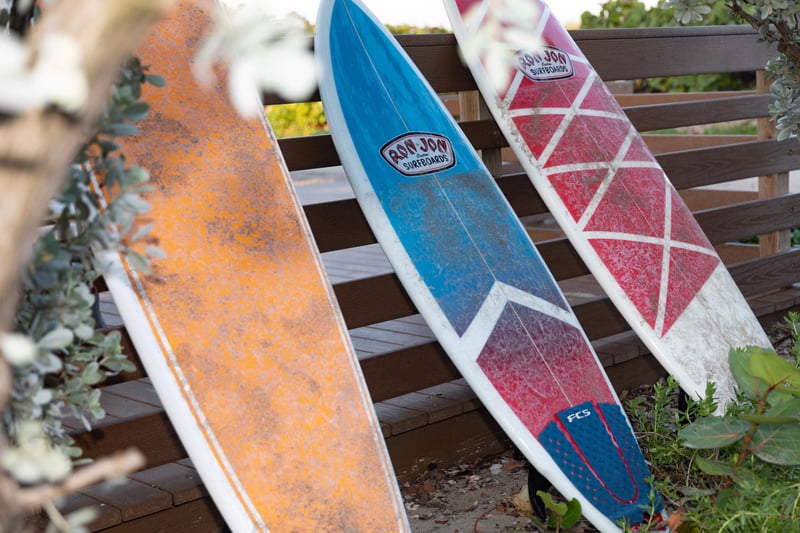April 25, 2023

Surf Lingo Post Two: Surfboard Terminology
Welcome back for our second session of the surfer lingo series. As you continue your journey into the surfing community, you should learn a few things about surfboards before you try to hang ten. Below is some key terminology for surfboards with an example of each term used in a sentence. While there is a lot of detailed information to learn about in the world of surfboards, we are going to stick with the basics for this session.
Deck: The top surface of the surfboard.
- Wax is applied to the deck of a surfboard.
Nose: A term used to describe the front end of a surfboard. Shortboards have a pointed nose while longboards typically have a rounded nose.
- Push the nose of your surfboard under the wave to start your duck dive.
Tail: A term used to describe the end opposite from the nose of a surfboard (the tail end, so to speak). There are thirteen different tail shapes, six of which are the fundamental shapes and seven that are more alternative designs. The tail shape has a significant impact on the board`s control, maneuverability, acceleration, stability, hold and release.
The six fundamental tail shapes are: square, squash, pin, round, swallow and asymmetrical.
- The surfer did a backhand tail whip which made for an amazing photo as the water sprayed from the tail of the board.
Rails: The rails are the actual edges of the surfboard which run along each side from the nose to the tail of the board. When you are holding a surfboard your hands are generally wrapped around the sides of the surfboard rails. How your board paddles, floats and turns in the water are all affected by the rails of your board.
- Rails are the primary connection point between the waves and surfboard.
Fin(s): The fins you put on your favorite surfboard can play a huge role in your performance on that board. Fins (located on the underside of the board) can affect the maneuverability, speed and stability of the surfboard. There are glassed-in fins meaning the fins are laminated into the surfboard itself and are not removable. And there are swappable or removable fins which can be changed out using a fin key. A few types of fin setups and their intended purposes are:
-- Single Fin: Traditionally used on longboards since they limit the turning radius of the board. Provides good speed and is ideal for slow, smooth turns.
-- Twin Fin/Dual Fin: A configuration of two fins typically used on shortboards for increased speed and maneuverability.
-- Tri Fin (or Thruster): Three fins is the most common set up on modern surfboards. Used on both long and shortboards the tri fin allows for high maneuverability and stability. This is a great fin setup for high-performance tricks.
- With my new tri fin surfboard, the turning is so precise that I am executing cutbacks with ease.
Stringer: A thin strip of wood running down the middle of a surfboard that reinforces the foam core. The stringer adds strength, rigidity and control to the flex of a surfboard. The stringer adds needed strength to the board, but the flex is important as it helps to project you forward through turns.
- The stringer strengthens your board, and it can also add additional color and design.
Leash: A urethane cord which attaches to the deck near the tail of the board. Surfers typically wear the leash around their ankle to prevent their board from being swept away when they wipeout.
- After a wipeout, a surfer can use their leash to retrieve their board quickly before paddling back into the lineup.
Ding: A dent, crack, hole, or fracture in the surface of a surfboard.
-- Pressure Ding: A dent in the surfboard that does not result in the resin cracking.
- The board has pressure dings from where the surfer always places their feet.
-- Standard Ding: A crack in the resin of the surfboard caused by an impact.
- Looks like your board has a standard ding from where the nose hit the car while loading up the boards.
Crease: Break in the surfboard which has not fully snapped in half.
- The surfer was coming out of the water after a wipeout and realized the impact caused his board to crease.
Quiver: A surfer’s collection of surfboards. Usually the collection contains a variety of surfboard shapes and sizes designed for different surf conditions.
- The surfer`s quiver contained a board once used by a world champion surfer.
We hope this helps you better understand basic surfboard terminology as you start your surfing journey. See you in the lineup!